Principles of Information Systems Report: The Fitness Center Project
VerifiedAdded on 2021/11/02
|13
|2672
|115
Report
AI Summary
This report focuses on the development of a new information system for The Fitness Center, a company with multiple locations and a large membership base. The project aims to provide a software system for members and fitness consultants to track health and fitness activities. The report outlines the project scope, goals, and the purpose of the new system, which includes data storage, maintenance, and retrieval. High-priority requirements are categorized into functional (login, registration, scheduling, package management, password changes, workout booking, and logout) and non-functional (user-friendly interface, availability, performance, security, privacy, robustness, usability, and flexibility) aspects. A detailed project plan, including tasks, durations, start and finish dates, predecessors, resources, and costs, is also presented. The project is estimated to take 73 days and cost $103,400.00, covering planning, requirements analysis, design, development, execution, and closeout phases. The report concludes that the new information system is essential for meeting the needs of the fitness center, improving client relationships, and streamlining operations.

Running head: PRINCIPLES OF INFORMATION SYSTEMS
Principles of Information Systems
A new information system for The Fitness Center
Student Name:
University Name:
Principles of Information Systems
A new information system for The Fitness Center
Student Name:
University Name:
Paraphrase This Document
Need a fresh take? Get an instant paraphrase of this document with our AI Paraphraser
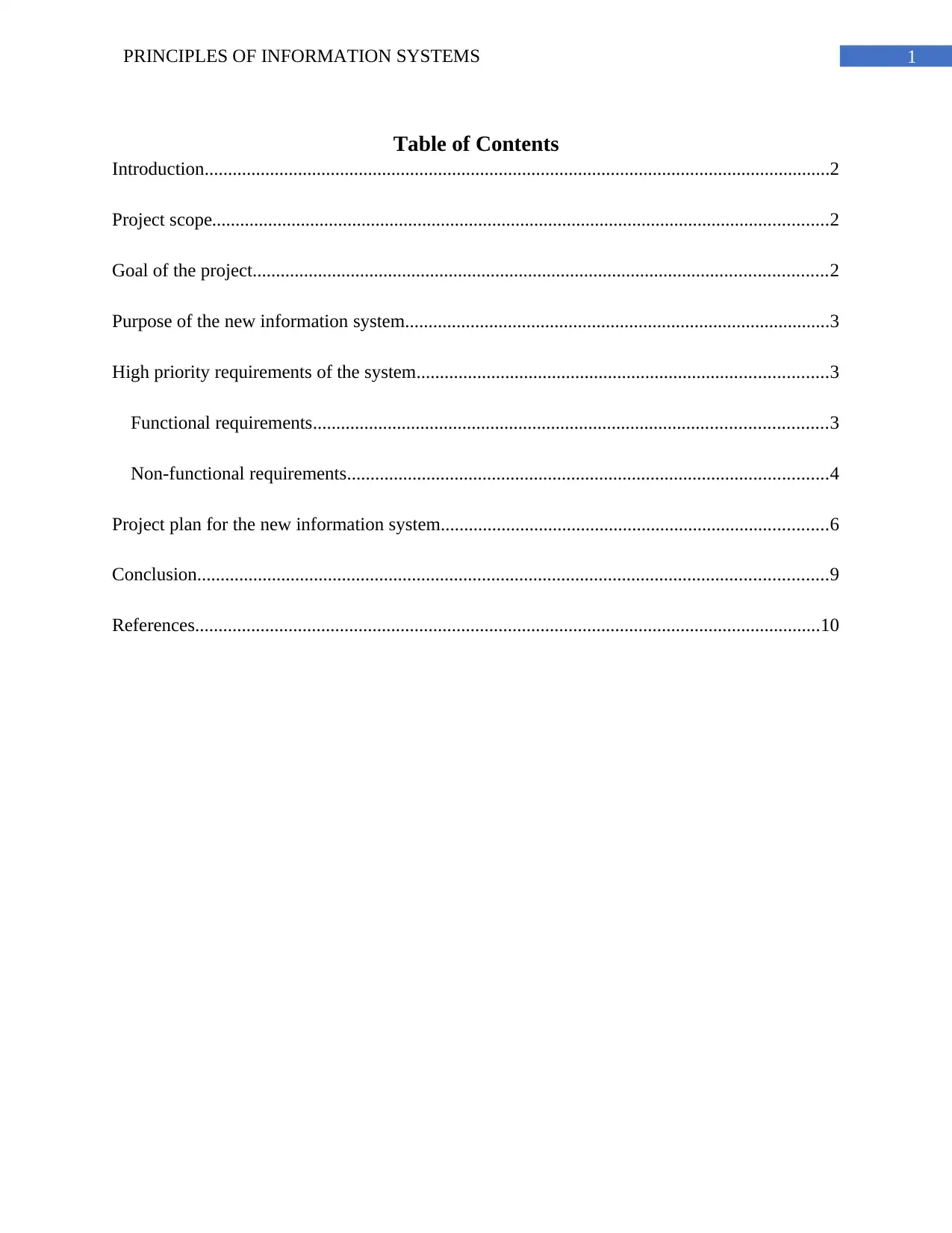
1PRINCIPLES OF INFORMATION SYSTEMS
Table of Contents
Introduction......................................................................................................................................2
Project scope....................................................................................................................................2
Goal of the project...........................................................................................................................2
Purpose of the new information system...........................................................................................3
High priority requirements of the system........................................................................................3
Functional requirements..............................................................................................................3
Non-functional requirements.......................................................................................................4
Project plan for the new information system...................................................................................6
Conclusion.......................................................................................................................................9
References......................................................................................................................................10
Table of Contents
Introduction......................................................................................................................................2
Project scope....................................................................................................................................2
Goal of the project...........................................................................................................................2
Purpose of the new information system...........................................................................................3
High priority requirements of the system........................................................................................3
Functional requirements..............................................................................................................3
Non-functional requirements.......................................................................................................4
Project plan for the new information system...................................................................................6
Conclusion.......................................................................................................................................9
References......................................................................................................................................10
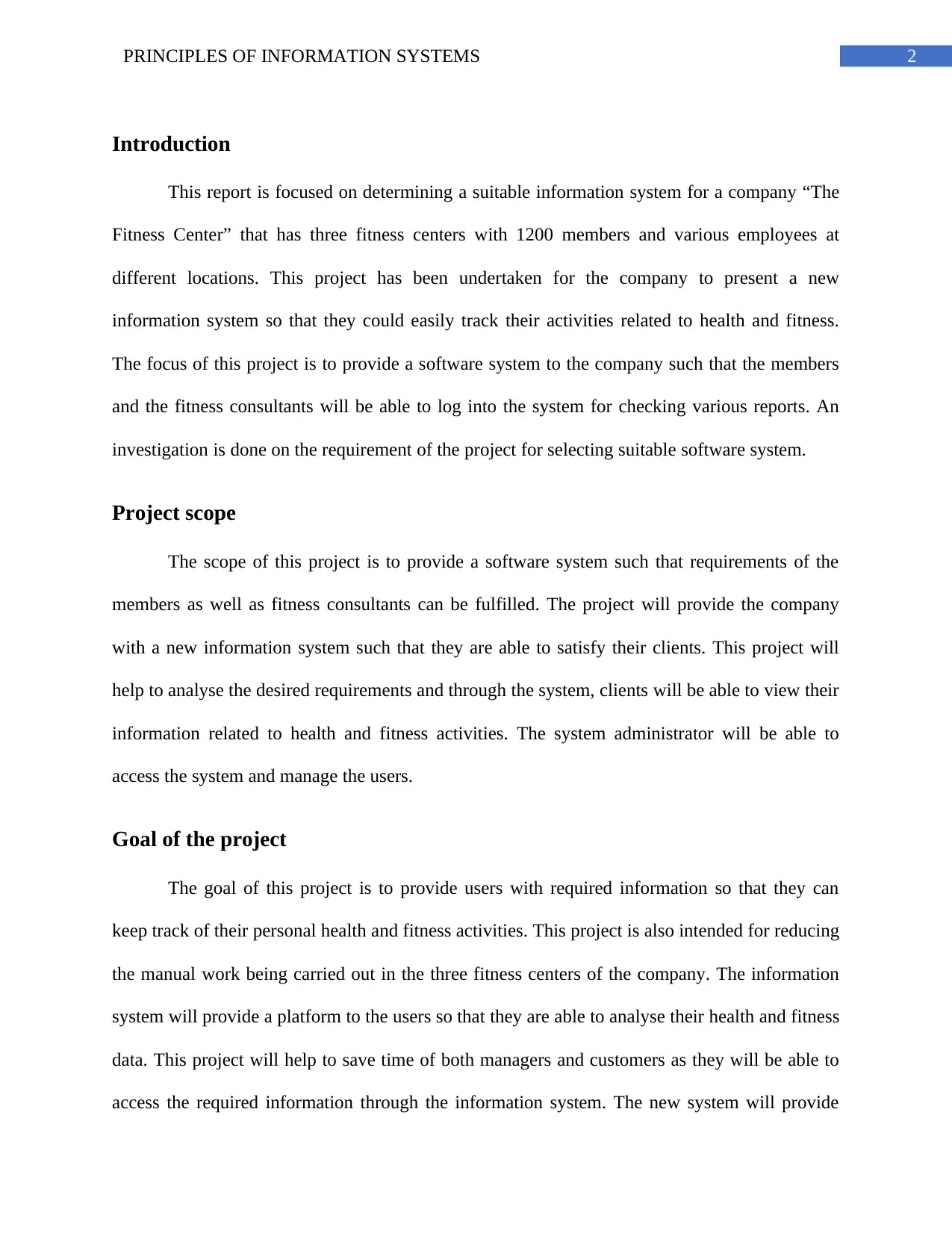
2PRINCIPLES OF INFORMATION SYSTEMS
Introduction
This report is focused on determining a suitable information system for a company “The
Fitness Center” that has three fitness centers with 1200 members and various employees at
different locations. This project has been undertaken for the company to present a new
information system so that they could easily track their activities related to health and fitness.
The focus of this project is to provide a software system to the company such that the members
and the fitness consultants will be able to log into the system for checking various reports. An
investigation is done on the requirement of the project for selecting suitable software system.
Project scope
The scope of this project is to provide a software system such that requirements of the
members as well as fitness consultants can be fulfilled. The project will provide the company
with a new information system such that they are able to satisfy their clients. This project will
help to analyse the desired requirements and through the system, clients will be able to view their
information related to health and fitness activities. The system administrator will be able to
access the system and manage the users.
Goal of the project
The goal of this project is to provide users with required information so that they can
keep track of their personal health and fitness activities. This project is also intended for reducing
the manual work being carried out in the three fitness centers of the company. The information
system will provide a platform to the users so that they are able to analyse their health and fitness
data. This project will help to save time of both managers and customers as they will be able to
access the required information through the information system. The new system will provide
Introduction
This report is focused on determining a suitable information system for a company “The
Fitness Center” that has three fitness centers with 1200 members and various employees at
different locations. This project has been undertaken for the company to present a new
information system so that they could easily track their activities related to health and fitness.
The focus of this project is to provide a software system to the company such that the members
and the fitness consultants will be able to log into the system for checking various reports. An
investigation is done on the requirement of the project for selecting suitable software system.
Project scope
The scope of this project is to provide a software system such that requirements of the
members as well as fitness consultants can be fulfilled. The project will provide the company
with a new information system such that they are able to satisfy their clients. This project will
help to analyse the desired requirements and through the system, clients will be able to view their
information related to health and fitness activities. The system administrator will be able to
access the system and manage the users.
Goal of the project
The goal of this project is to provide users with required information so that they can
keep track of their personal health and fitness activities. This project is also intended for reducing
the manual work being carried out in the three fitness centers of the company. The information
system will provide a platform to the users so that they are able to analyse their health and fitness
data. This project will help to save time of both managers and customers as they will be able to
access the required information through the information system. The new system will provide
You're viewing a preview
Unlock full access by subscribing today!
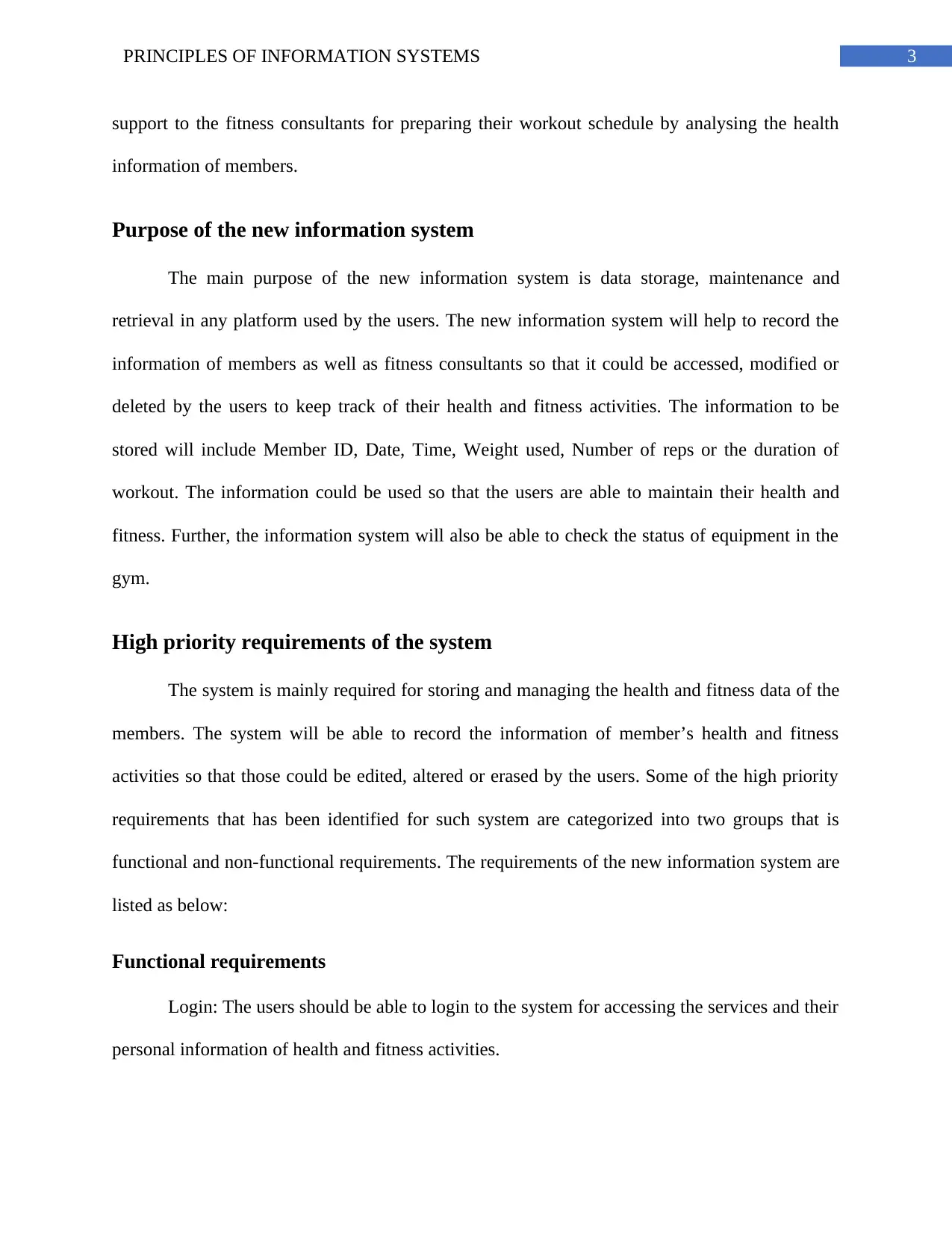
3PRINCIPLES OF INFORMATION SYSTEMS
support to the fitness consultants for preparing their workout schedule by analysing the health
information of members.
Purpose of the new information system
The main purpose of the new information system is data storage, maintenance and
retrieval in any platform used by the users. The new information system will help to record the
information of members as well as fitness consultants so that it could be accessed, modified or
deleted by the users to keep track of their health and fitness activities. The information to be
stored will include Member ID, Date, Time, Weight used, Number of reps or the duration of
workout. The information could be used so that the users are able to maintain their health and
fitness. Further, the information system will also be able to check the status of equipment in the
gym.
High priority requirements of the system
The system is mainly required for storing and managing the health and fitness data of the
members. The system will be able to record the information of member’s health and fitness
activities so that those could be edited, altered or erased by the users. Some of the high priority
requirements that has been identified for such system are categorized into two groups that is
functional and non-functional requirements. The requirements of the new information system are
listed as below:
Functional requirements
Login: The users should be able to login to the system for accessing the services and their
personal information of health and fitness activities.
support to the fitness consultants for preparing their workout schedule by analysing the health
information of members.
Purpose of the new information system
The main purpose of the new information system is data storage, maintenance and
retrieval in any platform used by the users. The new information system will help to record the
information of members as well as fitness consultants so that it could be accessed, modified or
deleted by the users to keep track of their health and fitness activities. The information to be
stored will include Member ID, Date, Time, Weight used, Number of reps or the duration of
workout. The information could be used so that the users are able to maintain their health and
fitness. Further, the information system will also be able to check the status of equipment in the
gym.
High priority requirements of the system
The system is mainly required for storing and managing the health and fitness data of the
members. The system will be able to record the information of member’s health and fitness
activities so that those could be edited, altered or erased by the users. Some of the high priority
requirements that has been identified for such system are categorized into two groups that is
functional and non-functional requirements. The requirements of the new information system are
listed as below:
Functional requirements
Login: The users should be able to login to the system for accessing the services and their
personal information of health and fitness activities.
Paraphrase This Document
Need a fresh take? Get an instant paraphrase of this document with our AI Paraphraser
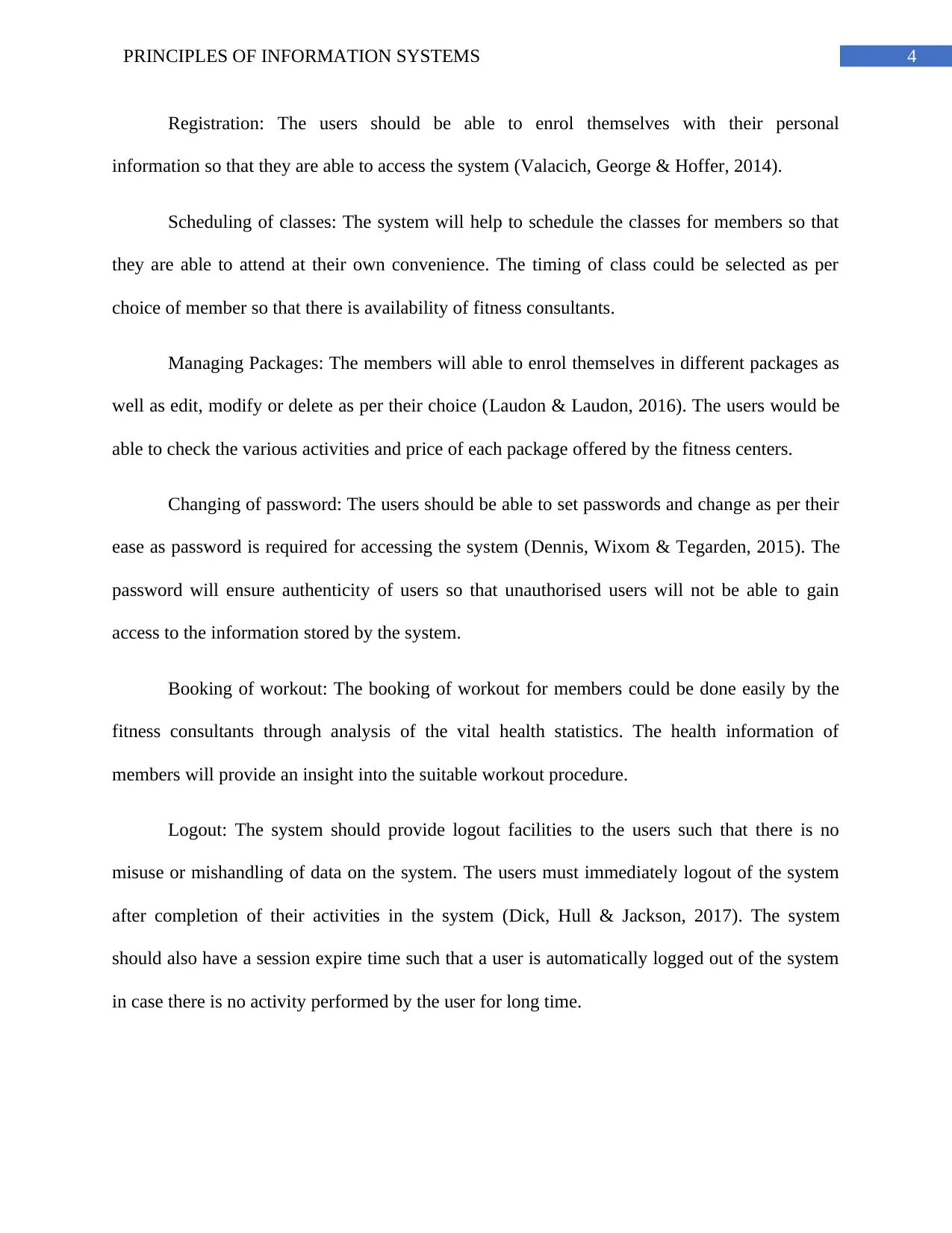
4PRINCIPLES OF INFORMATION SYSTEMS
Registration: The users should be able to enrol themselves with their personal
information so that they are able to access the system (Valacich, George & Hoffer, 2014).
Scheduling of classes: The system will help to schedule the classes for members so that
they are able to attend at their own convenience. The timing of class could be selected as per
choice of member so that there is availability of fitness consultants.
Managing Packages: The members will able to enrol themselves in different packages as
well as edit, modify or delete as per their choice (Laudon & Laudon, 2016). The users would be
able to check the various activities and price of each package offered by the fitness centers.
Changing of password: The users should be able to set passwords and change as per their
ease as password is required for accessing the system (Dennis, Wixom & Tegarden, 2015). The
password will ensure authenticity of users so that unauthorised users will not be able to gain
access to the information stored by the system.
Booking of workout: The booking of workout for members could be done easily by the
fitness consultants through analysis of the vital health statistics. The health information of
members will provide an insight into the suitable workout procedure.
Logout: The system should provide logout facilities to the users such that there is no
misuse or mishandling of data on the system. The users must immediately logout of the system
after completion of their activities in the system (Dick, Hull & Jackson, 2017). The system
should also have a session expire time such that a user is automatically logged out of the system
in case there is no activity performed by the user for long time.
Registration: The users should be able to enrol themselves with their personal
information so that they are able to access the system (Valacich, George & Hoffer, 2014).
Scheduling of classes: The system will help to schedule the classes for members so that
they are able to attend at their own convenience. The timing of class could be selected as per
choice of member so that there is availability of fitness consultants.
Managing Packages: The members will able to enrol themselves in different packages as
well as edit, modify or delete as per their choice (Laudon & Laudon, 2016). The users would be
able to check the various activities and price of each package offered by the fitness centers.
Changing of password: The users should be able to set passwords and change as per their
ease as password is required for accessing the system (Dennis, Wixom & Tegarden, 2015). The
password will ensure authenticity of users so that unauthorised users will not be able to gain
access to the information stored by the system.
Booking of workout: The booking of workout for members could be done easily by the
fitness consultants through analysis of the vital health statistics. The health information of
members will provide an insight into the suitable workout procedure.
Logout: The system should provide logout facilities to the users such that there is no
misuse or mishandling of data on the system. The users must immediately logout of the system
after completion of their activities in the system (Dick, Hull & Jackson, 2017). The system
should also have a session expire time such that a user is automatically logged out of the system
in case there is no activity performed by the user for long time.
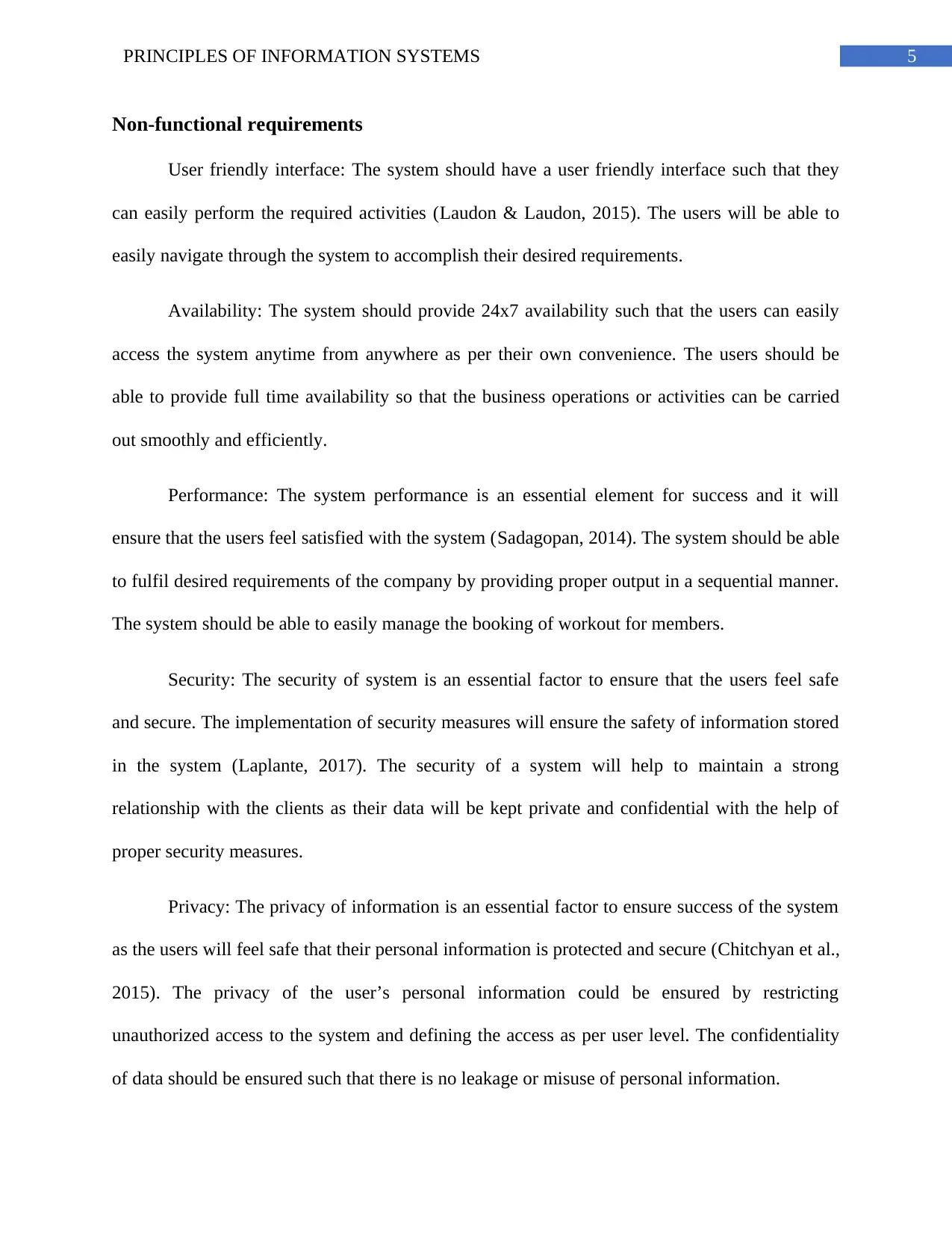
5PRINCIPLES OF INFORMATION SYSTEMS
Non-functional requirements
User friendly interface: The system should have a user friendly interface such that they
can easily perform the required activities (Laudon & Laudon, 2015). The users will be able to
easily navigate through the system to accomplish their desired requirements.
Availability: The system should provide 24x7 availability such that the users can easily
access the system anytime from anywhere as per their own convenience. The users should be
able to provide full time availability so that the business operations or activities can be carried
out smoothly and efficiently.
Performance: The system performance is an essential element for success and it will
ensure that the users feel satisfied with the system (Sadagopan, 2014). The system should be able
to fulfil desired requirements of the company by providing proper output in a sequential manner.
The system should be able to easily manage the booking of workout for members.
Security: The security of system is an essential factor to ensure that the users feel safe
and secure. The implementation of security measures will ensure the safety of information stored
in the system (Laplante, 2017). The security of a system will help to maintain a strong
relationship with the clients as their data will be kept private and confidential with the help of
proper security measures.
Privacy: The privacy of information is an essential factor to ensure success of the system
as the users will feel safe that their personal information is protected and secure (Chitchyan et al.,
2015). The privacy of the user’s personal information could be ensured by restricting
unauthorized access to the system and defining the access as per user level. The confidentiality
of data should be ensured such that there is no leakage or misuse of personal information.
Non-functional requirements
User friendly interface: The system should have a user friendly interface such that they
can easily perform the required activities (Laudon & Laudon, 2015). The users will be able to
easily navigate through the system to accomplish their desired requirements.
Availability: The system should provide 24x7 availability such that the users can easily
access the system anytime from anywhere as per their own convenience. The users should be
able to provide full time availability so that the business operations or activities can be carried
out smoothly and efficiently.
Performance: The system performance is an essential element for success and it will
ensure that the users feel satisfied with the system (Sadagopan, 2014). The system should be able
to fulfil desired requirements of the company by providing proper output in a sequential manner.
The system should be able to easily manage the booking of workout for members.
Security: The security of system is an essential factor to ensure that the users feel safe
and secure. The implementation of security measures will ensure the safety of information stored
in the system (Laplante, 2017). The security of a system will help to maintain a strong
relationship with the clients as their data will be kept private and confidential with the help of
proper security measures.
Privacy: The privacy of information is an essential factor to ensure success of the system
as the users will feel safe that their personal information is protected and secure (Chitchyan et al.,
2015). The privacy of the user’s personal information could be ensured by restricting
unauthorized access to the system and defining the access as per user level. The confidentiality
of data should be ensured such that there is no leakage or misuse of personal information.
You're viewing a preview
Unlock full access by subscribing today!
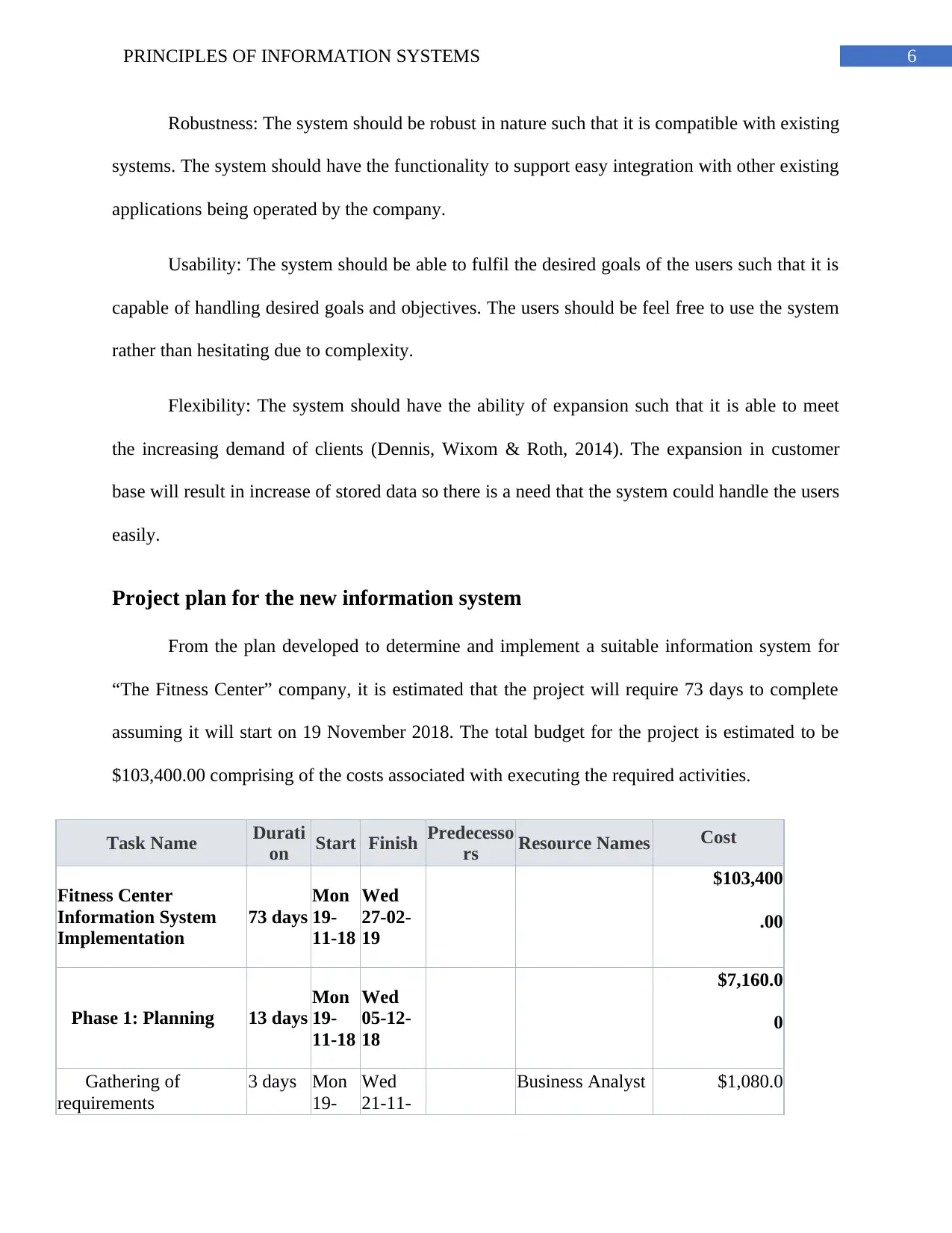
6PRINCIPLES OF INFORMATION SYSTEMS
Robustness: The system should be robust in nature such that it is compatible with existing
systems. The system should have the functionality to support easy integration with other existing
applications being operated by the company.
Usability: The system should be able to fulfil the desired goals of the users such that it is
capable of handling desired goals and objectives. The users should be feel free to use the system
rather than hesitating due to complexity.
Flexibility: The system should have the ability of expansion such that it is able to meet
the increasing demand of clients (Dennis, Wixom & Roth, 2014). The expansion in customer
base will result in increase of stored data so there is a need that the system could handle the users
easily.
Project plan for the new information system
From the plan developed to determine and implement a suitable information system for
“The Fitness Center” company, it is estimated that the project will require 73 days to complete
assuming it will start on 19 November 2018. The total budget for the project is estimated to be
$103,400.00 comprising of the costs associated with executing the required activities.
Task Name Durati
on Start Finish Predecesso
rs Resource Names Cost
Fitness Center
Information System
Implementation
73 days
Mon
19-
11-18
Wed
27-02-
19
$103,400
.00
Phase 1: Planning 13 days
Mon
19-
11-18
Wed
05-12-
18
$7,160.0
0
Gathering of
requirements
3 days Mon
19-
Wed
21-11-
Business Analyst $1,080.0
Robustness: The system should be robust in nature such that it is compatible with existing
systems. The system should have the functionality to support easy integration with other existing
applications being operated by the company.
Usability: The system should be able to fulfil the desired goals of the users such that it is
capable of handling desired goals and objectives. The users should be feel free to use the system
rather than hesitating due to complexity.
Flexibility: The system should have the ability of expansion such that it is able to meet
the increasing demand of clients (Dennis, Wixom & Roth, 2014). The expansion in customer
base will result in increase of stored data so there is a need that the system could handle the users
easily.
Project plan for the new information system
From the plan developed to determine and implement a suitable information system for
“The Fitness Center” company, it is estimated that the project will require 73 days to complete
assuming it will start on 19 November 2018. The total budget for the project is estimated to be
$103,400.00 comprising of the costs associated with executing the required activities.
Task Name Durati
on Start Finish Predecesso
rs Resource Names Cost
Fitness Center
Information System
Implementation
73 days
Mon
19-
11-18
Wed
27-02-
19
$103,400
.00
Phase 1: Planning 13 days
Mon
19-
11-18
Wed
05-12-
18
$7,160.0
0
Gathering of
requirements
3 days Mon
19-
Wed
21-11-
Business Analyst $1,080.0
Paraphrase This Document
Need a fresh take? Get an instant paraphrase of this document with our AI Paraphraser
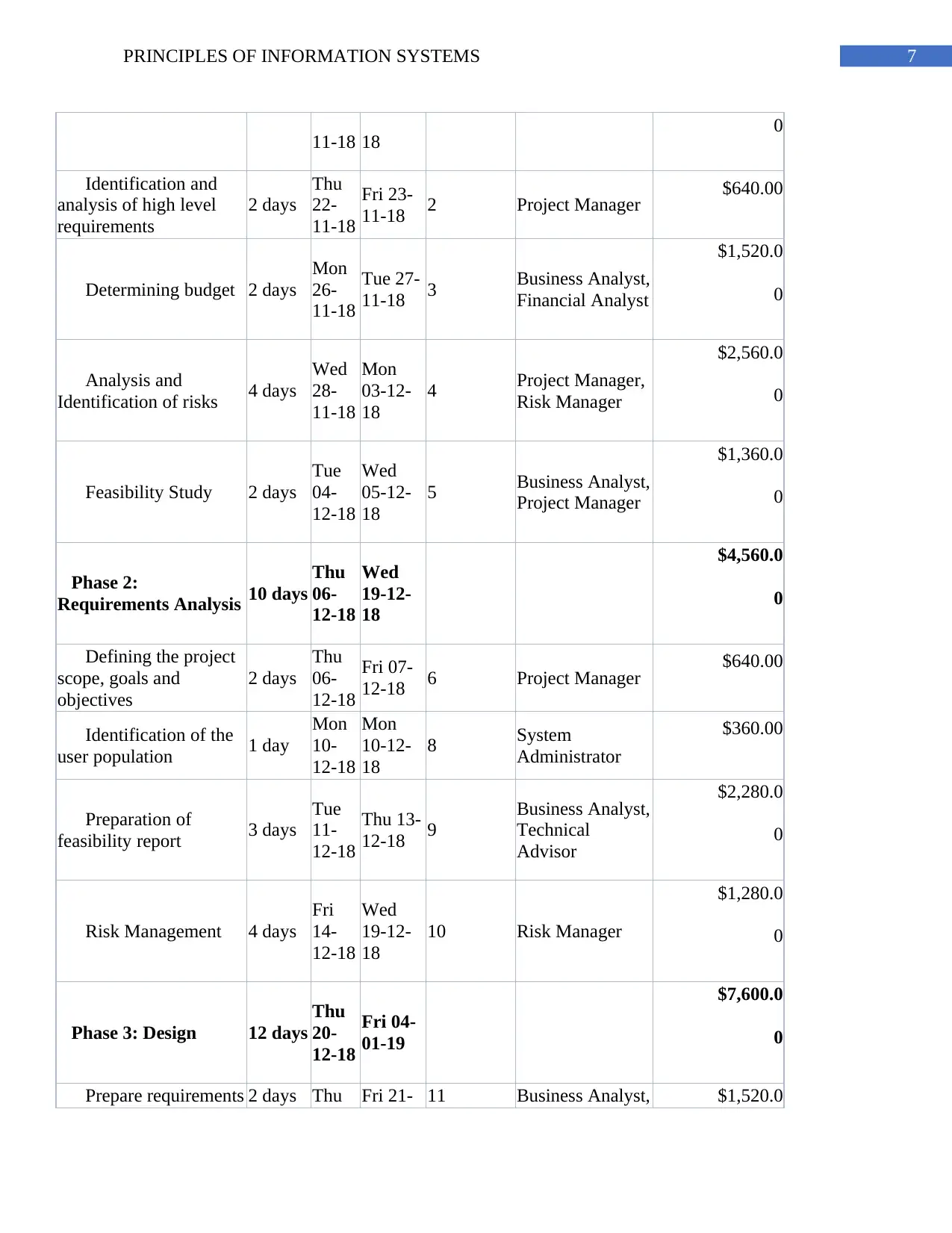
7PRINCIPLES OF INFORMATION SYSTEMS
11-18 18 0
Identification and
analysis of high level
requirements
2 days
Thu
22-
11-18
Fri 23-
11-18 2 Project Manager $640.00
Determining budget 2 days
Mon
26-
11-18
Tue 27-
11-18 3 Business Analyst,
Financial Analyst
$1,520.0
0
Analysis and
Identification of risks 4 days
Wed
28-
11-18
Mon
03-12-
18
4 Project Manager,
Risk Manager
$2,560.0
0
Feasibility Study 2 days
Tue
04-
12-18
Wed
05-12-
18
5 Business Analyst,
Project Manager
$1,360.0
0
Phase 2:
Requirements Analysis 10 days
Thu
06-
12-18
Wed
19-12-
18
$4,560.0
0
Defining the project
scope, goals and
objectives
2 days
Thu
06-
12-18
Fri 07-
12-18 6 Project Manager $640.00
Identification of the
user population 1 day
Mon
10-
12-18
Mon
10-12-
18
8 System
Administrator
$360.00
Preparation of
feasibility report 3 days
Tue
11-
12-18
Thu 13-
12-18 9
Business Analyst,
Technical
Advisor
$2,280.0
0
Risk Management 4 days
Fri
14-
12-18
Wed
19-12-
18
10 Risk Manager
$1,280.0
0
Phase 3: Design 12 days
Thu
20-
12-18
Fri 04-
01-19
$7,600.0
0
Prepare requirements 2 days Thu Fri 21- 11 Business Analyst, $1,520.0
11-18 18 0
Identification and
analysis of high level
requirements
2 days
Thu
22-
11-18
Fri 23-
11-18 2 Project Manager $640.00
Determining budget 2 days
Mon
26-
11-18
Tue 27-
11-18 3 Business Analyst,
Financial Analyst
$1,520.0
0
Analysis and
Identification of risks 4 days
Wed
28-
11-18
Mon
03-12-
18
4 Project Manager,
Risk Manager
$2,560.0
0
Feasibility Study 2 days
Tue
04-
12-18
Wed
05-12-
18
5 Business Analyst,
Project Manager
$1,360.0
0
Phase 2:
Requirements Analysis 10 days
Thu
06-
12-18
Wed
19-12-
18
$4,560.0
0
Defining the project
scope, goals and
objectives
2 days
Thu
06-
12-18
Fri 07-
12-18 6 Project Manager $640.00
Identification of the
user population 1 day
Mon
10-
12-18
Mon
10-12-
18
8 System
Administrator
$360.00
Preparation of
feasibility report 3 days
Tue
11-
12-18
Thu 13-
12-18 9
Business Analyst,
Technical
Advisor
$2,280.0
0
Risk Management 4 days
Fri
14-
12-18
Wed
19-12-
18
10 Risk Manager
$1,280.0
0
Phase 3: Design 12 days
Thu
20-
12-18
Fri 04-
01-19
$7,600.0
0
Prepare requirements 2 days Thu Fri 21- 11 Business Analyst, $1,520.0
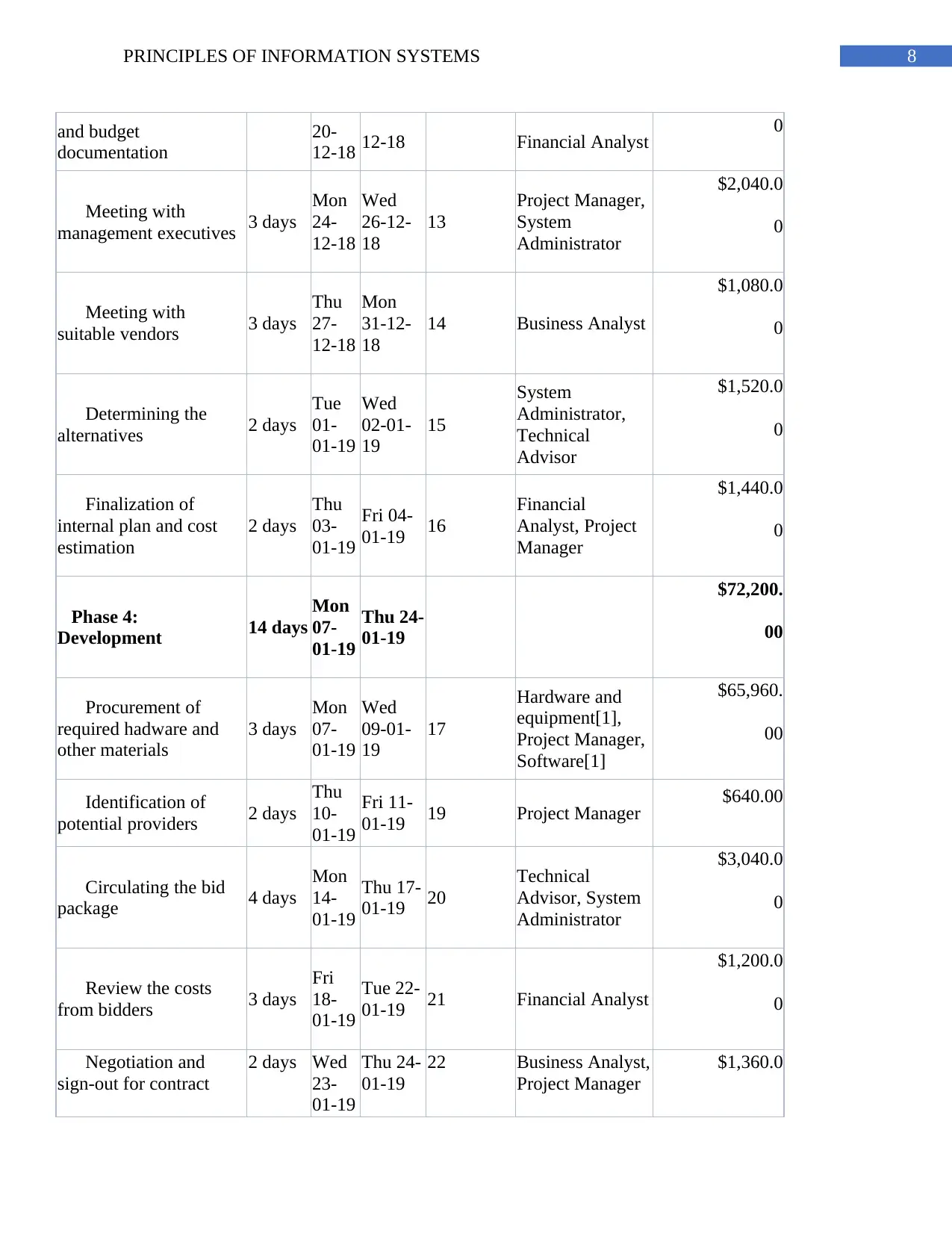
8PRINCIPLES OF INFORMATION SYSTEMS
and budget
documentation
20-
12-18 12-18 Financial Analyst 0
Meeting with
management executives 3 days
Mon
24-
12-18
Wed
26-12-
18
13
Project Manager,
System
Administrator
$2,040.0
0
Meeting with
suitable vendors 3 days
Thu
27-
12-18
Mon
31-12-
18
14 Business Analyst
$1,080.0
0
Determining the
alternatives 2 days
Tue
01-
01-19
Wed
02-01-
19
15
System
Administrator,
Technical
Advisor
$1,520.0
0
Finalization of
internal plan and cost
estimation
2 days
Thu
03-
01-19
Fri 04-
01-19 16
Financial
Analyst, Project
Manager
$1,440.0
0
Phase 4:
Development 14 days
Mon
07-
01-19
Thu 24-
01-19
$72,200.
00
Procurement of
required hadware and
other materials
3 days
Mon
07-
01-19
Wed
09-01-
19
17
Hardware and
equipment[1],
Project Manager,
Software[1]
$65,960.
00
Identification of
potential providers 2 days
Thu
10-
01-19
Fri 11-
01-19 19 Project Manager $640.00
Circulating the bid
package 4 days
Mon
14-
01-19
Thu 17-
01-19 20
Technical
Advisor, System
Administrator
$3,040.0
0
Review the costs
from bidders 3 days
Fri
18-
01-19
Tue 22-
01-19 21 Financial Analyst
$1,200.0
0
Negotiation and
sign-out for contract
2 days Wed
23-
01-19
Thu 24-
01-19
22 Business Analyst,
Project Manager
$1,360.0
and budget
documentation
20-
12-18 12-18 Financial Analyst 0
Meeting with
management executives 3 days
Mon
24-
12-18
Wed
26-12-
18
13
Project Manager,
System
Administrator
$2,040.0
0
Meeting with
suitable vendors 3 days
Thu
27-
12-18
Mon
31-12-
18
14 Business Analyst
$1,080.0
0
Determining the
alternatives 2 days
Tue
01-
01-19
Wed
02-01-
19
15
System
Administrator,
Technical
Advisor
$1,520.0
0
Finalization of
internal plan and cost
estimation
2 days
Thu
03-
01-19
Fri 04-
01-19 16
Financial
Analyst, Project
Manager
$1,440.0
0
Phase 4:
Development 14 days
Mon
07-
01-19
Thu 24-
01-19
$72,200.
00
Procurement of
required hadware and
other materials
3 days
Mon
07-
01-19
Wed
09-01-
19
17
Hardware and
equipment[1],
Project Manager,
Software[1]
$65,960.
00
Identification of
potential providers 2 days
Thu
10-
01-19
Fri 11-
01-19 19 Project Manager $640.00
Circulating the bid
package 4 days
Mon
14-
01-19
Thu 17-
01-19 20
Technical
Advisor, System
Administrator
$3,040.0
0
Review the costs
from bidders 3 days
Fri
18-
01-19
Tue 22-
01-19 21 Financial Analyst
$1,200.0
0
Negotiation and
sign-out for contract
2 days Wed
23-
01-19
Thu 24-
01-19
22 Business Analyst,
Project Manager
$1,360.0
You're viewing a preview
Unlock full access by subscribing today!
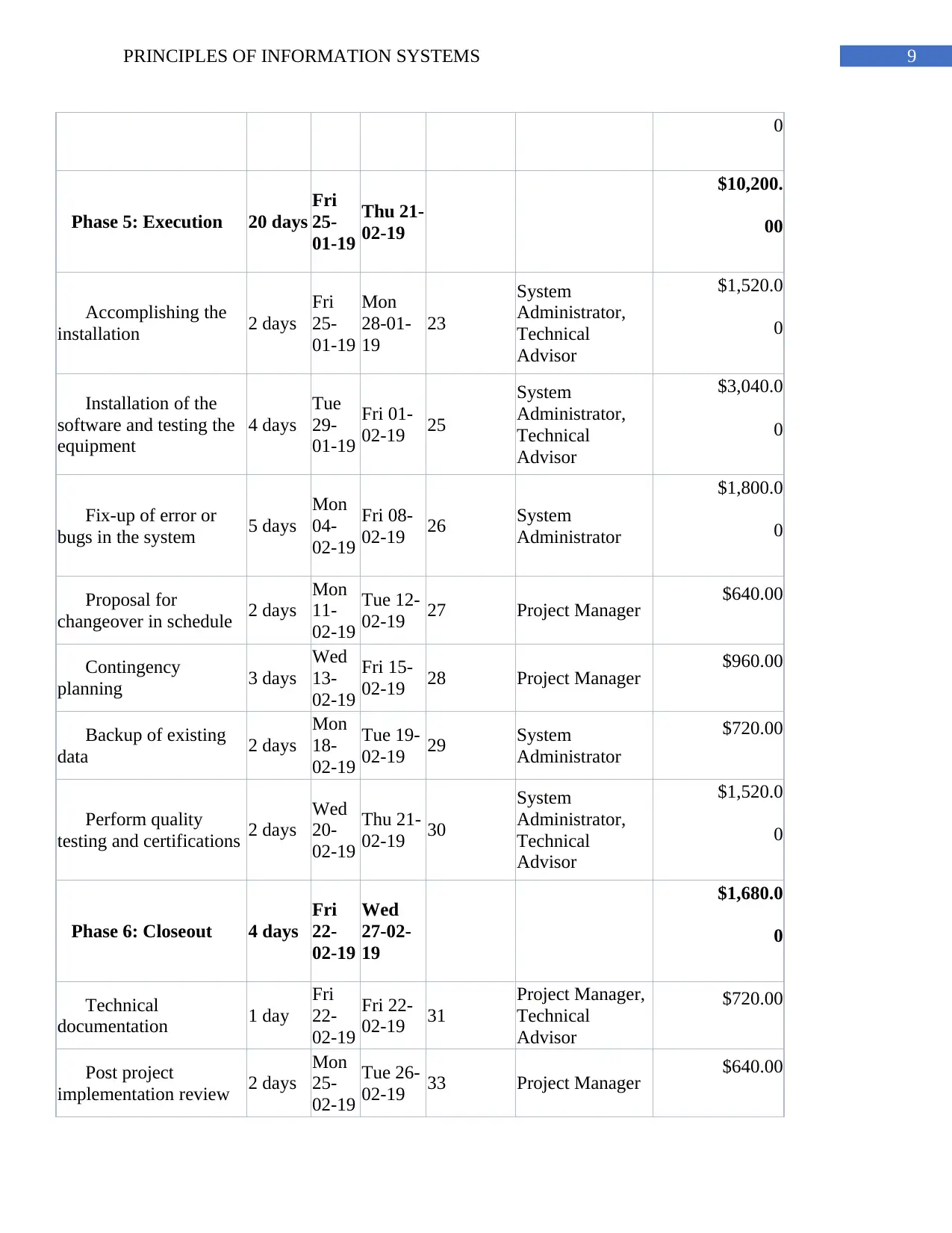
9PRINCIPLES OF INFORMATION SYSTEMS
0
Phase 5: Execution 20 days
Fri
25-
01-19
Thu 21-
02-19
$10,200.
00
Accomplishing the
installation 2 days
Fri
25-
01-19
Mon
28-01-
19
23
System
Administrator,
Technical
Advisor
$1,520.0
0
Installation of the
software and testing the
equipment
4 days
Tue
29-
01-19
Fri 01-
02-19 25
System
Administrator,
Technical
Advisor
$3,040.0
0
Fix-up of error or
bugs in the system 5 days
Mon
04-
02-19
Fri 08-
02-19 26 System
Administrator
$1,800.0
0
Proposal for
changeover in schedule 2 days
Mon
11-
02-19
Tue 12-
02-19 27 Project Manager $640.00
Contingency
planning 3 days
Wed
13-
02-19
Fri 15-
02-19 28 Project Manager $960.00
Backup of existing
data 2 days
Mon
18-
02-19
Tue 19-
02-19 29 System
Administrator
$720.00
Perform quality
testing and certifications 2 days
Wed
20-
02-19
Thu 21-
02-19 30
System
Administrator,
Technical
Advisor
$1,520.0
0
Phase 6: Closeout 4 days
Fri
22-
02-19
Wed
27-02-
19
$1,680.0
0
Technical
documentation 1 day
Fri
22-
02-19
Fri 22-
02-19 31
Project Manager,
Technical
Advisor
$720.00
Post project
implementation review 2 days
Mon
25-
02-19
Tue 26-
02-19 33 Project Manager $640.00
0
Phase 5: Execution 20 days
Fri
25-
01-19
Thu 21-
02-19
$10,200.
00
Accomplishing the
installation 2 days
Fri
25-
01-19
Mon
28-01-
19
23
System
Administrator,
Technical
Advisor
$1,520.0
0
Installation of the
software and testing the
equipment
4 days
Tue
29-
01-19
Fri 01-
02-19 25
System
Administrator,
Technical
Advisor
$3,040.0
0
Fix-up of error or
bugs in the system 5 days
Mon
04-
02-19
Fri 08-
02-19 26 System
Administrator
$1,800.0
0
Proposal for
changeover in schedule 2 days
Mon
11-
02-19
Tue 12-
02-19 27 Project Manager $640.00
Contingency
planning 3 days
Wed
13-
02-19
Fri 15-
02-19 28 Project Manager $960.00
Backup of existing
data 2 days
Mon
18-
02-19
Tue 19-
02-19 29 System
Administrator
$720.00
Perform quality
testing and certifications 2 days
Wed
20-
02-19
Thu 21-
02-19 30
System
Administrator,
Technical
Advisor
$1,520.0
0
Phase 6: Closeout 4 days
Fri
22-
02-19
Wed
27-02-
19
$1,680.0
0
Technical
documentation 1 day
Fri
22-
02-19
Fri 22-
02-19 31
Project Manager,
Technical
Advisor
$720.00
Post project
implementation review 2 days
Mon
25-
02-19
Tue 26-
02-19 33 Project Manager $640.00
Paraphrase This Document
Need a fresh take? Get an instant paraphrase of this document with our AI Paraphraser
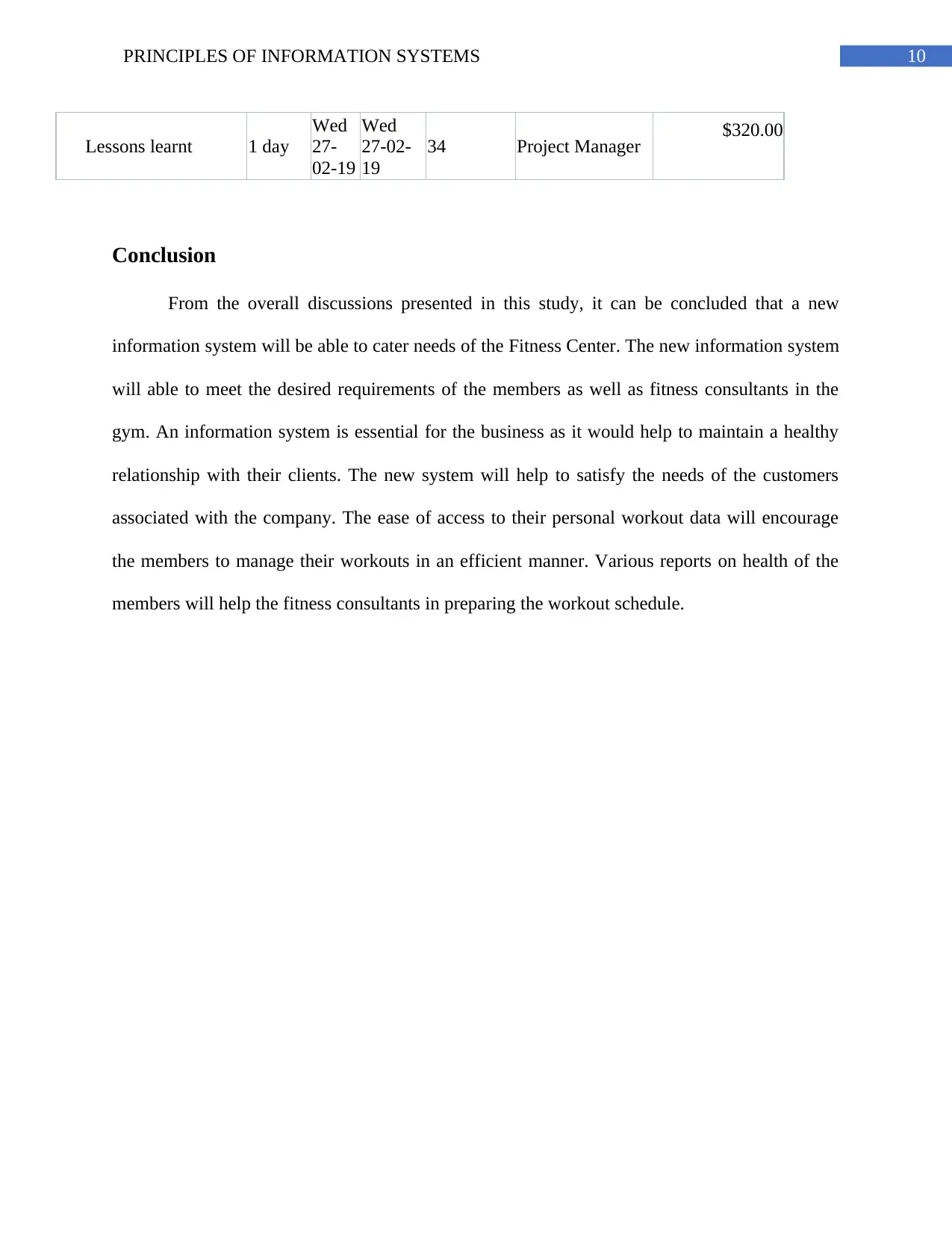
10PRINCIPLES OF INFORMATION SYSTEMS
Lessons learnt 1 day
Wed
27-
02-19
Wed
27-02-
19
34 Project Manager $320.00
Conclusion
From the overall discussions presented in this study, it can be concluded that a new
information system will be able to cater needs of the Fitness Center. The new information system
will able to meet the desired requirements of the members as well as fitness consultants in the
gym. An information system is essential for the business as it would help to maintain a healthy
relationship with their clients. The new system will help to satisfy the needs of the customers
associated with the company. The ease of access to their personal workout data will encourage
the members to manage their workouts in an efficient manner. Various reports on health of the
members will help the fitness consultants in preparing the workout schedule.
Lessons learnt 1 day
Wed
27-
02-19
Wed
27-02-
19
34 Project Manager $320.00
Conclusion
From the overall discussions presented in this study, it can be concluded that a new
information system will be able to cater needs of the Fitness Center. The new information system
will able to meet the desired requirements of the members as well as fitness consultants in the
gym. An information system is essential for the business as it would help to maintain a healthy
relationship with their clients. The new system will help to satisfy the needs of the customers
associated with the company. The ease of access to their personal workout data will encourage
the members to manage their workouts in an efficient manner. Various reports on health of the
members will help the fitness consultants in preparing the workout schedule.
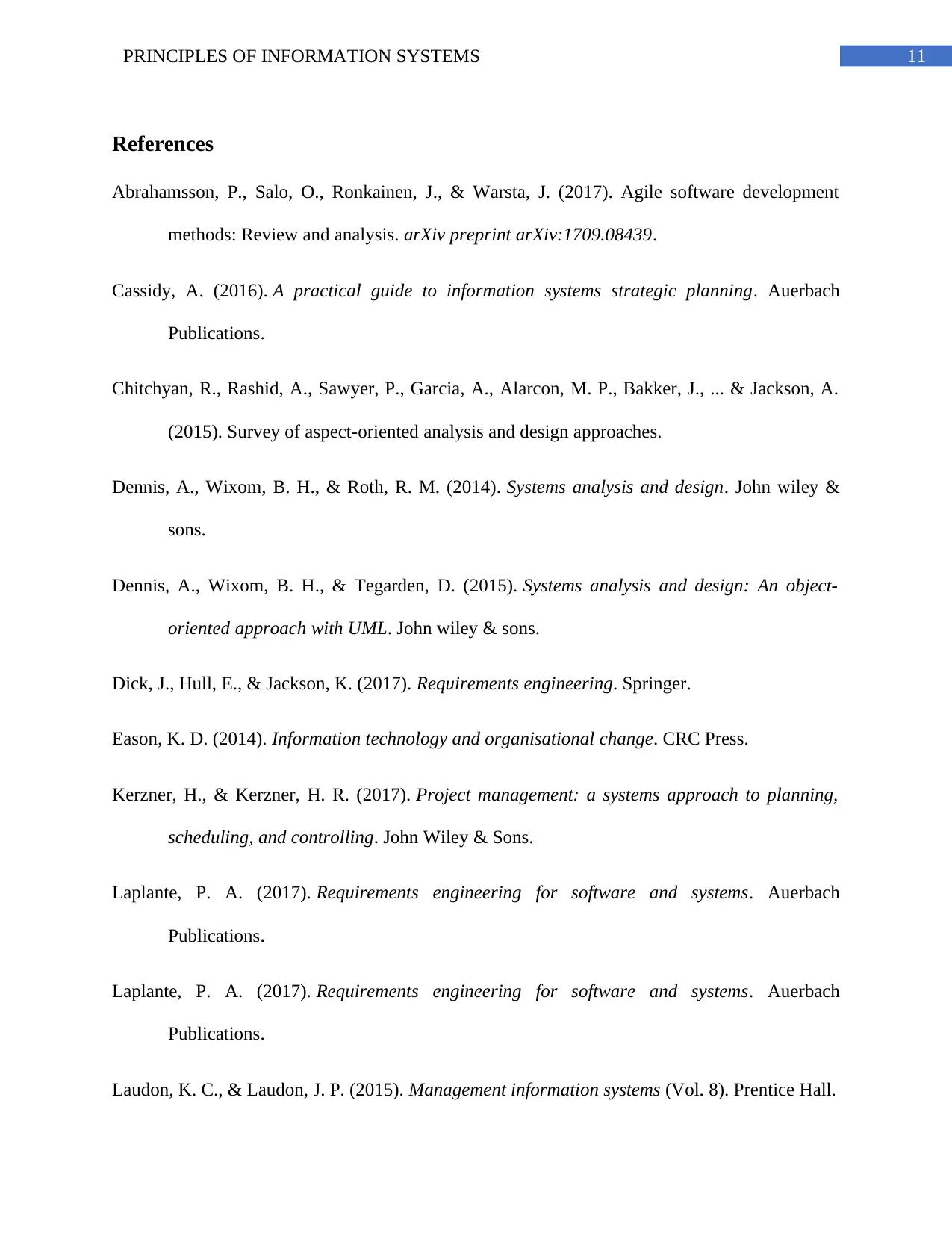
11PRINCIPLES OF INFORMATION SYSTEMS
References
Abrahamsson, P., Salo, O., Ronkainen, J., & Warsta, J. (2017). Agile software development
methods: Review and analysis. arXiv preprint arXiv:1709.08439.
Cassidy, A. (2016). A practical guide to information systems strategic planning. Auerbach
Publications.
Chitchyan, R., Rashid, A., Sawyer, P., Garcia, A., Alarcon, M. P., Bakker, J., ... & Jackson, A.
(2015). Survey of aspect-oriented analysis and design approaches.
Dennis, A., Wixom, B. H., & Roth, R. M. (2014). Systems analysis and design. John wiley &
sons.
Dennis, A., Wixom, B. H., & Tegarden, D. (2015). Systems analysis and design: An object-
oriented approach with UML. John wiley & sons.
Dick, J., Hull, E., & Jackson, K. (2017). Requirements engineering. Springer.
Eason, K. D. (2014). Information technology and organisational change. CRC Press.
Kerzner, H., & Kerzner, H. R. (2017). Project management: a systems approach to planning,
scheduling, and controlling. John Wiley & Sons.
Laplante, P. A. (2017). Requirements engineering for software and systems. Auerbach
Publications.
Laplante, P. A. (2017). Requirements engineering for software and systems. Auerbach
Publications.
Laudon, K. C., & Laudon, J. P. (2015). Management information systems (Vol. 8). Prentice Hall.
References
Abrahamsson, P., Salo, O., Ronkainen, J., & Warsta, J. (2017). Agile software development
methods: Review and analysis. arXiv preprint arXiv:1709.08439.
Cassidy, A. (2016). A practical guide to information systems strategic planning. Auerbach
Publications.
Chitchyan, R., Rashid, A., Sawyer, P., Garcia, A., Alarcon, M. P., Bakker, J., ... & Jackson, A.
(2015). Survey of aspect-oriented analysis and design approaches.
Dennis, A., Wixom, B. H., & Roth, R. M. (2014). Systems analysis and design. John wiley &
sons.
Dennis, A., Wixom, B. H., & Tegarden, D. (2015). Systems analysis and design: An object-
oriented approach with UML. John wiley & sons.
Dick, J., Hull, E., & Jackson, K. (2017). Requirements engineering. Springer.
Eason, K. D. (2014). Information technology and organisational change. CRC Press.
Kerzner, H., & Kerzner, H. R. (2017). Project management: a systems approach to planning,
scheduling, and controlling. John Wiley & Sons.
Laplante, P. A. (2017). Requirements engineering for software and systems. Auerbach
Publications.
Laplante, P. A. (2017). Requirements engineering for software and systems. Auerbach
Publications.
Laudon, K. C., & Laudon, J. P. (2015). Management information systems (Vol. 8). Prentice Hall.
You're viewing a preview
Unlock full access by subscribing today!
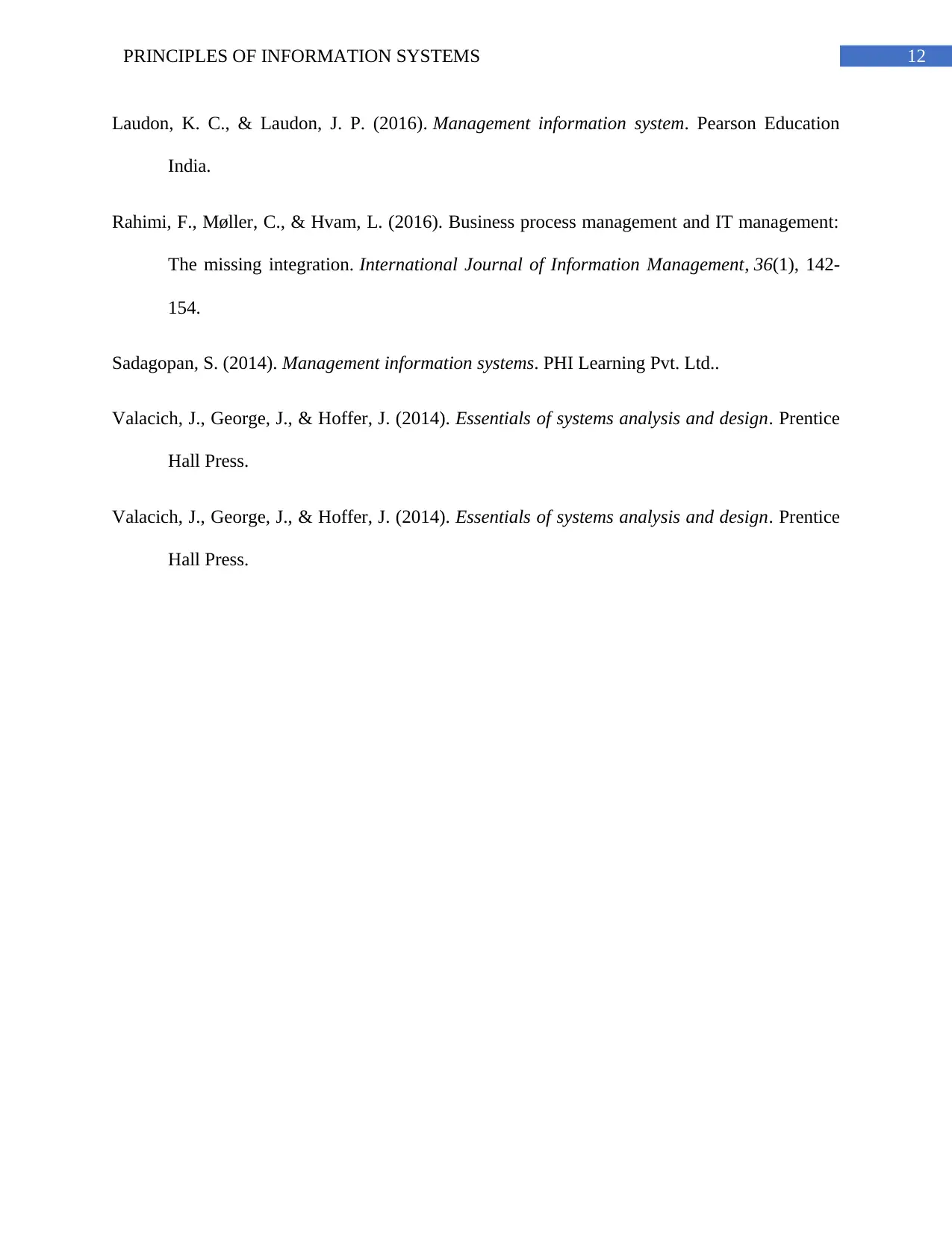
12PRINCIPLES OF INFORMATION SYSTEMS
Laudon, K. C., & Laudon, J. P. (2016). Management information system. Pearson Education
India.
Rahimi, F., Møller, C., & Hvam, L. (2016). Business process management and IT management:
The missing integration. International Journal of Information Management, 36(1), 142-
154.
Sadagopan, S. (2014). Management information systems. PHI Learning Pvt. Ltd..
Valacich, J., George, J., & Hoffer, J. (2014). Essentials of systems analysis and design. Prentice
Hall Press.
Valacich, J., George, J., & Hoffer, J. (2014). Essentials of systems analysis and design. Prentice
Hall Press.
Laudon, K. C., & Laudon, J. P. (2016). Management information system. Pearson Education
India.
Rahimi, F., Møller, C., & Hvam, L. (2016). Business process management and IT management:
The missing integration. International Journal of Information Management, 36(1), 142-
154.
Sadagopan, S. (2014). Management information systems. PHI Learning Pvt. Ltd..
Valacich, J., George, J., & Hoffer, J. (2014). Essentials of systems analysis and design. Prentice
Hall Press.
Valacich, J., George, J., & Hoffer, J. (2014). Essentials of systems analysis and design. Prentice
Hall Press.
1 out of 13
Related Documents
Your All-in-One AI-Powered Toolkit for Academic Success.
+13062052269
info@desklib.com
Available 24*7 on WhatsApp / Email
![[object Object]](/_next/static/media/star-bottom.7253800d.svg)
Unlock your academic potential
© 2024 | Zucol Services PVT LTD | All rights reserved.




